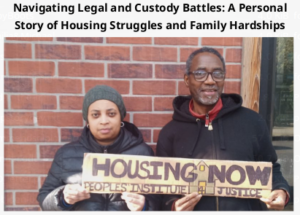[PDF]

After knowing Carmilla and Michael for over 10 years, I was inspired by my aunt’s work with Art for the Homeless that raises funds for shelters, to write about their struggles, that many homeless folks face echoed by Carmilla & Michael’s story. So many people fall through the cracks of social support systems— they simply don’t fit the mold for assistance.
In the complex landscape of public housing and public assistance, many families face daunting challenges beyond simply finding a place to live. Amid the legal intricacies, unsympathetic landlords and systemic issues combined to create a cycle of hardship that has tested Carmilla and Michael in more ways than one. Their story involves not just struggles with Section 8 housing but also legal battles over custody of their children and the failure of the system to recognize and support them as domestic partners. Despite the immense challenges, they continue to fight for stability and justice in a system that often seems stacked against them.
The Section 8 Struggle
Carmilla’s journey with Section 8 housing began in the late 1990s when she obtained a voucher to help provide a stable home for herself and her children. However, using a Section 8 voucher is often fraught with challenges. Carmilla and Michael had to deal with landlords more interested in exploiting the system than providing adequate housing. Their move to Harvey, Illinois, exposed them to one such landlord, who Michael describes as “grifting off Section 8” caring little for the tenants or their living conditions. The lack of accountability in the system meant that tenants like Carmilla and Michael were left vulnerable to exploitation. While Harvey was the first of many housing challenges, it was far from the last. As they moved between cities, they found that the combination of an unsupportive housing authority and exploitative landlords would make it nearly impossible to maintain stable housing. Their experience highlighted a critical flaw in the Section 8 system: While it provides housing assistance, it fails to protect tenants from unethical landlords.
The Move to Detroit: Searching for Stability
After being homeless for about six months in Chicago, Carmilla and Michael had to make a difficult decision to relocate to Detroit. The move, born out of desperation, was a gamble—they hoped that by starting over, they might find some stability. However, the challenges followed them across state lines. They found housing, but once again, they faced landlords more interested in exploiting the system than providing safe, livable homes.Detroit offered a fresh start. Securing Section 8 housing was easy to obtain and public assistance gave financial help to pay utilities. But, the two-flat they eventually moved into was structurally unsafe due to a cracked foundation. Carmilla, Michael and their children lived in Detroit from July 2000 – November 2005.
Section 8 Under Investigation
After moving back to Chicago, Carmilla had to participate in the welfare-to-work program to continue receiving financial and food assistance. Carmilla had to become a work-for-hire employee to receive their monthly benefit check and food stamps.
Their housing struggles began in 2008 during recertification, her Section 8 status came under investigation by the Chicago Housing Authority (CHA). The CHA claimed that Carmilla had failed to report her income, even though she had been transparent about her part-time work becoming full-time and had followed the rules. The investigation, spurred by missing pay stubs and bureaucratic confusion, accused her of not paying rent for an entire year—despite having receipts to prove otherwise.
The investigation was a significant blow to their efforts to maintain stable housing. If Carmilla could not clear up the discrepancies, she risked losing her Section 8 voucher. “They told us we owed over $2,000 in back rent,” Michael recalls, “but even if we paid, there was no guarantee Carmilla would retain her keep voucher.” This kind of bureaucratic entanglement, where the system seemed designed to entrap rather than support families, left Carmilla and Michael in a constant state of anxiety.Legal Entanglements and Custody Battles As if navigating the Section 8 system wasn’t challenging enough, Carmilla and Michael faced a series of custody battles involving their children. In 2010, Carmilla’s half-sister accused the couple of mistreating their children, triggering an investigation by the Department of Children and Family Services (DCFS). These accusations, which Michael insists were based on lies and teenage rebellion, placed the couple under the microscope of a system that often fails to account for the nuances of family dynamics.
Their oldest daughter made false claims of abuse and neglect to gain more freedom; as Michael explains, “She was just at that age where she wanted to hang out and do whatever she wanted.” Their oldest son was also struggling, cutting classes and getting involved with the wrong crowd. These actions, though rooted in typical teenage behavior, were enough to bring DCFS into their lives, adding yet another layer of stress to their already precarious situation. The fear of losing their children hung over them, even as they battled to maintain stable housing.
Falling Through the Cracks of Support as Domestic Partners
One challenge Carmilla and Michael faced was the lack of recognition of their domestic partnership. Despite living together for years and raising children, they were not legally married, which created additional barriers to accessing support. Public assistance programs and legal protections are often designed around traditional family structures, leaving domestic partners like Carmilla and Michael without the same rights and resources as married couples.This gap in recognition meant that they were not a couple but individuals rather than a family unit, both in legal battles over custody and their dealings with CHA, “We were not respected as a real family in their eyes” Michael says, pointing to how the system failed to account for their domestic partnership. This lack of recognition further isolated them from the support they needed in a difficult situation even more challenging.
The Legal Fight to Stay Together
Throughout this time, Carmilla and Michael were determined to stay together and keep their family intact. The constant legal battles took a toll on their relationship, but their bond remained strong. They fought to present a united front, even as the system treated them as individuals. The lack of legal recognition for their partnership continued to complicate their efforts to navigate the various bureaucratic hurdles placed in their way.
Despite the many challenges, Carmilla and Michael refused to give up. They sought legal help, but the lawyers they initially encountered were more interested in getting them to settle rather than fight; as Michael recalls, “Most of the lawyers just wanted us to pay the back rent and move on.” It was not until they connected with a more dedicated attorney that they began to see progress in their legal battles with their landlords and the CHA.
Living in Limbo
For four years, Carmilla and Michael lived under the shadow of the CHA investigation, struggling to keep their housing while fighting for their future. The pressure of Carmilla possibly losing her Section 8 voucher. Compounded by their ongoing custody battles with DCFS investigating their ability to care for their children at the same time that CHA was scrutinizing their ability to keep their home. To add further insult to their housing issues. Carmilla and Michael were stuck living in substandard housing conditions in a building owned by another grifting landlord who was not being held accountable by CHA. It was a precarious existence that highlights how families like theirs can fall through the cracks of support.
Occupying Abandoned Homes: A Bold Act of Defiance
In 2012 after years of housing instability, Carmilla and Michael became involved in a community effort to occupy abandoned homes. The financial crisis in 2008 had left many houses vacant and saw an opportunity to fight back against the banks and private equity firms profiting from the housing crisis.
Carmilla and Micheal had to move out of their apartment in January 2013. CHA had decided Carmilla could not participate in the Section 8 program. They moved into an abandoned foreclosed bank-owned home in Rogers Park, hoping to turn it into a livable space for their family.
This bold act of defiance was a practical and symbolic stand against a system that had repeatedly failed them. The abandoned foreclosed bank-owned home they occupied had been left to decay and had become a blighted home on the block. Carmilla and Michael, with the assistance of volunteers fighting against foreclosure and evictions, decided to occupy the property clean and repair it, transforming it into a place they could call home. The neighbors on each side of the house were happy that someone was there and making the home a safe space.
The Arrest and Legal Aftermath
After occupying the house for over 90 Days, “They came with a full tactical squad.” Michael recalled describing how the police forcefully removed them from the property. It was a traumatic experience for them and marked the beginning of a legal battle that would see them arrested twice in two days.
After their arrest, the home they had hoped to occupy was no longer an option and they were back to square one—without a home. Their belongings, including her much-needed medications, were locked inside the house, having to rely on community members and the housing group to help them retrieve their possessions.
The Search for Accountability
During the aftermath of their eviction and arrest, Carmilla and Michael turned their attention to uncovering the truth about the company that had purchased the home two months after they moved in. Invitation Homes, a housing rental company and owned subsidiary of The Blackstone Group, Michael spent countless hours researching the company, discovering that Blackstone had been buying thousands of homes across the country in the wake of the financial crisis. In The meantime, a radical housing lawyer who fought for the people and housing as a human right signed on to represent Carmilla and Michael and filed a lawsuit against Invitation Homes for illegal eviction and stealing a significant amount of their property and damages.
His research revealed the troubling extent of corporate control over housing, with private equity firms like Blackstone profiting from the crisis they had helped create;this was a bitter pill to swallow—while companies like Blackstone continued to build wealth from the housing market collapse.
Conclusion: A Call for Change
Their story is a powerful testament to the struggles of low-income families when the system designed to support them instead works against them. The trauma of housing instability and child custody battles highlight the deep flaws in public assistance programs, the challenges of navigating family law and the lack of recognition for non-traditional family structures. Despite the many obstacles they have faced. Carmilla and Michael continue to fight for housing as a human right. Their story is not just one of hardship but of resilience and determination. It is time
to reform housing policies, legal protections and social support systems. So families like theirs are not left to fall through the cracks. In a world where corporate interests often take precedence over the needs of individuals, their fight for justice is a reminder of the human cost of systemic failure and the urgent need for change.
![]()





